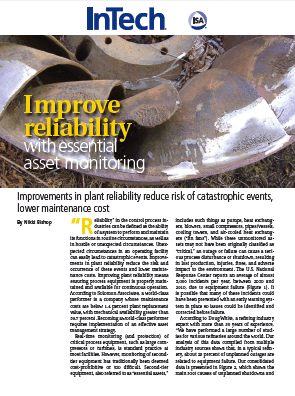“According to Solomon Associates, a world-class performer is a company whose maintenance costs are below 1.4 percent plant replacement value, with mechanical availability greater than 96.7 percent.” Are your maintenance costs below this 1.4% threshold and 96.7% mechanical availability metrics?
 If not, you may want to read the InTech article, Improve reliability with essential asset monitoring by Emerson’s Nikki Bishop, a senior application consultant.
If not, you may want to read the InTech article, Improve reliability with essential asset monitoring by Emerson’s Nikki Bishop, a senior application consultant.
Nikki notes that most critical assets including large compressors and turbines are using instrumented with real-time machinery monitoring equipment. Less critical but essential assets include:
…such things as pumps, heat exchangers, blowers, small compressors, pipes/vessels, cooling towers, and air-cooled heat exchangers (“fin fans”).
She pointed to some studies by Emerson’s Doug White, whom you may recall from earlier project justification and optimization-related posts. She quotes Doug:
Our analysis of this data compiled from multiple industry sources shows that, in a typical refinery, about 25 percent of unplanned outages are related to equipment failure… shows the main root causes of unplanned shutdowns and slowdowns and the unit availability loss associated with each. According to our studies, just seven asset classes account for the majority of the loss: valves, pumps, vessels, compressors, piping, exchangers, and fired equipment…
Based on our industry analysis, maintenance of these same seven asset classes consumes about 70 percent of the total maintenance budget at a typical refinery.
Given these statistics, you have choices for your asset management strategy. Nikki notes:
Selecting the right asset management strategy is a balancing act between implementation cost and expected reliability. Reactive maintenance represents the most costly and least reliable maintenance program.
Issues with a preventive maintenance approach are that it:
…calls for schedule-based asset servicing, whether maintenance is necessary or not. While this approach may offer greater reliability than a run-to-failure method, it has its own drawbacks. Valuable time and resources are wasted servicing assets that may not require repair. The personnel busy unnecessarily servicing assets could easily be doing other productive work instead. And if the assets being serviced do not have a spare, the process is unnecessarily disrupted, costing valuable production time.
Predictive maintenance can be done manually through periodic rounds or automatically via machinery protection instrumentation. Downsides with the manual approach:
…based on periodic—possibly infrequent—data acquisition fails to give real-time insight into asset health. Thus, equipment may fail during the interim of data acquisition, causing process disruption and a more costly repair than a well-maintained asset. Resources are wasted sending skilled personnel for data collection into the field, which might also be a hazardous environment. Additionally, analysis and interpretation of collected data requires the skills of a trained reliability engineer or equipment specialist. The problem is compounded as experienced personnel retire and take their vast stores of knowledge with them.
With automated monitoring, it:
Wireless vibration transmitters, such as the CSI 9420 can instrument hard to reach or cost prohibitive essential assets. Machinery data along with process data:…can detect process conditions that may be unintentionally and unknowingly inducing a fault on equipment. Armed with the knowledge of adverse process conditions, operators can make adjustments so that process-related equipment faults can be avoided altogether. In the event of impending failure, online indication of asset health provides advanced warning of health degradation that allows enough time for spare equipment to be safely brought online, eliminating process upsets, off-spec product, and safety incidents that result from an unexpected trip.
…such as pressure, temperature, or flow, along with asset data, such as vibration or bearing temperature, identifies specific process conditions that may cause asset health degradation. Adverse process conditions can be detected and adjustments made to prevent further asset damage.
Nikki highlights some examples where the automated monitoring can help provide early warning for conditions such as pump cavitation, combustion air blowers, and heat exchanger fouling. Nikki also provides calculations for a typical 250,000 barrel-per-day refinery, where:
…effective essential asset monitoring program could be worth up to $14.7 million based just on identifying developing faults.
If you’re looking for ways to get your maintenance costs in line with top performing process manufacturers, give the article some of your precious bandwidth.





